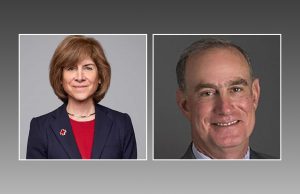When Komen Arizona announced in late June that it would cease operations when its affiliate agreement expired on July 31, the Phoenix-based chapter became the latest and largest to merge or dissolve, a move that has increased dramatically during the past two years.
Dozens of affiliates of the breast cancer charity have merged in recent years, with more on the way, in a bid to strengthen affiliates to at least the $1 million level in annual revenue. Many national charities have reorganized their affiliate structure during the past decade, includ ing the American Can cer Society, the American Heart Association, and most recently, the Alzheimer’s Association.

During the past five years, 19 Komen affiliates merged or dissolved, including 11 in the fiscal year ending 2016, with cumulative total assets of almost $4 million. Of the 19, four dissolved and 15 merged into other affiliates. The shrinkage has brought the total number of affiliates nationwide to 103, down from 114 in 2015 and a high of 123 in 2010. That doesn’t include more than a dozen mergers or dissolutions announced since the end of the last fiscal year (April 2016). The number could fall below 80 by the end of this fiscal year (March 2018).
As some other affiliates have lamented, Komen Arizona Executive Director Christine Mencuccini cited declining participation and revenue in its signature Race for the Cure events.
The Phoenix race drew 30,000 participants at its peak in 2010, regularly grossing among the top 10 affiliates including $2 million as recently as 2016, according to Komen financial statements. Last year’s race included 7,500 participants, a drop-off from the previous year’s 10,000 mark. Race revenue was down from about $919,000 in 2015 to $585,000 last year.
How much impact is still felt from the 2012 episode involving Planned Parenthood also is difficult to measure but likely has some residual effect. Komen had announced changes to its grant-making in early 2012, sparking backlash from Planned Parenthood, which no longer would be eligible. Komen later reversed its decision but not before a media frenzy and public relations fiasco ensued, with executive turnover at the organization in the ensuing months. Revenue and participation in fundraising events has waned across the sector over the past decade, with increased competition from for-profit as well as charitable events like endurance races.
Unlike other affiliates that have been able to merge with nearby Komen neighbors, Arizona was left without realistic options, only 18 months after Komen Arizona was formed as a result of a merger between the Southern Arizona affiliate and the Northern and Central Arizona affiliate. The closest affiliates geographically were in Southern California, Nevada, Utah and Colorado, which Mencuccini said weren’t realistic as potential partners.
Komen’s consolidation plans have been going on for at least six years, according to Lori Maris, senior vice president of the affiliate network at the national office and a former executive director of Komen Greater Kansas City.
In addition to Arizona, affiliates in El Paso, eastern Washington, Maine and Wyoming have either closed within the past year or are pending dissolution. Others have announced mergers, including three affiliates in Iowa becoming Komen Greater Iowa as well as affiliate mergers in Tennessee and Texas. Some mergers are still pending regulatory approval, including four affiliates across New York State that will become Komen Upstate New York.
In a federated organization, tension between local affiliates and a national office is not uncommon with typical concerns about decision making and control. When Alzheimer’s Association reorganized several years ago, a handful of affiliates decided to remain independent amid concerns about providing direct care and support and local fundraising.
The Eastern Washington affiliate already was considering not staying with Komen for a number of reasons, according to Deborah Barnes, who was hired as a consultant last summer and later became acting executive director. She is now executive director of Spokane, Wash.-based Every Woman Can, which is funded through local organizations while it works toward its nonprofit designation and focused on breast cancer and breast health, advocacy and support for survivors and their families.
“As an affiliate, we had very little control over decisions made by the national organizations or its responses to various issues on a national level,” she said. In theory, merging seems like a sound idea but conversations with other affiliates made it seem more like one affiliate was absorbed by another, and coverage for an area was bound to get lost in the shuffle, including the loss of local sponsors who feared the 75 percent of their dollars would no longer stay local.
“When we reached out to partners and collaborators, no one supported a merge,” Barnes said.

Wyoming just doesn’t have the capacity to raise $1 million a year to stay as an affiliate, according to Laurie Heath, who was on the board of Komen Wyoming. She is now part of the team at Wyoming Breast Cancer Initiative (WBCI), funded with the help of a three-year pilot project from the Wyoming Community Foundation. The local Komen affiliate had raised as much as $550,000 some years. So with headquarters encouraging mergers to reach that $1 million level, Wyoming reached out to Komen affiliates in Colorado, Nebraska and Utah. Only Nebraska seemed interested, Heath said, and in that scenario Wyoming would remain a volunteer organization, sending funds to Nebraska and applying for grants.
Many more mergers are likely if the $1-million mark is a hard and fast rule for affiliate revenue. In Fiscal Year Ending 2016, about 58 affiliates had combined revenue from races and contributions of more than $1 million, with another two affiliates within $5,000 of seven figures. The year before, there were 60 affiliates in seven figures.
Twice as many affiliates (69) reported less revenue from races and contributions in 2016 than the previous year than those that reported more (32). Of those reporting more revenue, 21 reported increases of at least 10 percent and 11 of at least 25 percent.
Among 102 affiliates in Fiscal Year Ending 2016, the median combined revenue and contributions change was a decline of about 7 percent. In terms of dollar figures, the median combined revenue and contributions were more than $1.2 million.
Affiliates that experienced some of the most drastic declines in revenue the past few years have been those that shared revenue with the national office from the Susan G. Komen 3-Day, a 60-mile walk coordinated by the national office. Race for the Cure 5Ks are put on by local affiliates. The number of 3-Day walks was reduced from 14 to seven in 2014, hitting some affiliates especially hard, such as those in the San Francisco Bay area and the Florida Suncoast affiliate.
The Florida Suncoast affiliate had the largest decline in net assets of any Komen affiliate -90 percent, from about $700,000 in 2012 to less than $67,000 in 2016. At least three other affiliates that had the biggest decreases in net assets have dissolved, with another pending, and at least one other one has merged. The St. Petersburg, Fla.-based Florida Suncoast affiliate had the second-largest drop in contributions during that time, down 87 percent, from $1.187 million in 2012 (which still had some 3-Day race revenue) to $156,000 last year.
Revenue from the 3-Day fluctuated from year-to-year based on results of the overall series, which was highly dependent on individual participant fundraising, said Gina Kravitz, executive director of Komen Florida Suncoast. The revenue is divided between the national office, which managed the event, and evenly among host city affiliates. Florida Suncoast used to receive a full host city share, whereas the Michigan 3-Day split revenue among more than one affiliate.
The Planned Parenthood episode “certainly generated strong feelings among some on both sides of the issue at the time. For some who felt ost strongly, it probably did change their participation since then,” Kravitz said. “While some have come back, we know some haven’t. We understand and respect that. But it also means we have to work harder to educate the rest of our community about the work we are doing and the positive impact they can help us make on the lives of their neighbors,” she said.
The Planned Parenthood issue might have affected some affiliates more than others. What worked before no longer did, according to Barnes, who was acting executive director of the former Eastern Washington affiliate. “The community divided over those issues and what began as a conversation about breast cancer and breast health devolved into a conversation about politics and philosophy,” she said.
Florida Suncoast remains among the smallest affiliates, which could lead to it being among the next batch to merge. “Much like all of our Komen colleagues we regularly analyze our operations and local impact. As part of that, we are continuing to evaluate all options for sustainability and future growth,” Kravitz said when asked whether it will pursue a merger with another affiliate.
Contributions for the average affiliate were less than $450,000 in 2016 compared with almost $560,000 in 2012, a difference of nearly 20 percent. Similar drops among affiliates were seen in net assets, declining 31 percent from $82.6 million to $57.2 million between 2012 and 2016 and 24 percent in combined race revenue, from $175 million to $113 million.
Contributions, race revenue and net assets of the more than 100 affiliates have dropped by anywhere from 25 percent to 35 percent since Fiscal Year 2012. That’s the year before the public dispute with Planned Parenthood. The spat with Planned Parenthood is long over and while there might be some residual effect, it’s hard to quantify how much. It also hasn’t helped that revenue and participation in fundraising events has waned across the sector during the past decade, with increased competition from for-profit as well as charitable events like endurance races.
A review of Komen’s financial data since 2012 shows that contributions for all affiliates combined was $46 million for the fiscal year ending March 2016, which is down by 31 percent from the $67 million reported in 2012. Data for the fiscal year spanning April 2016 to March 2017 is not yet available.
Affiliates began in many communities as grassroots campaigns with a group of people who wanted to begin a Komen chapter and to organize a 5K walk/run, according to Maris. “It was essentially a community need assessment,” she said. “As we built that way organically over the last 36 years, that part has really matured. It really became clear our organizational structure evolved,” she added. A lot of things have changed since Komen’s founding in 1982, including nonprofits, healthcare, breast health and the delivery mechanism, and increased competition for donor dollars.
A review of Komen’s financial data since 2012 shows that contributions for all affiliates combined was $46 million for the fiscal year ending March 2016; down by 31% from the $67 million reported in 2012.

Affiliates without staff were pleading for help and consolidations in recent years have been an organic process, with affiliates looking to nearby sister affiliates. A one-person staff wears a lot of hats, Maris said, and affiliates have struggled from a volunteer perspective in recent years.
Maris knows first-hand the difficulties of being a one-person operation. She was a staff of one in Kansas City, with annual revenue of about $600,000. “I cried a lot the first year,” she quipped. By the time she left the affiliate a decade later, it was staffed with eight employees and a budget of more than $2 million.
The $1-million revenue level and a staff of four is where affiliates start to see a difference. “Your accountant didn’t have to be your attorney. You could diversify your people’s time and talent to see what they’re best at. It allows us to expand mission,” she said. “You really can start to diversify, say, mission development, have one person on grant development and one on how to create programs, find community partners.”
When it comes to mergers, Maris employs the analogy of dating: affiliates looking for a partner that is a good fit, evaluating their strengths and areas of improvement. “You look for someone who helps build you up. You’re stronger as a couple than one person not pulling your weight,” she said. “By the time affiliates get to the legal filing stage, we’re looking for long-term marriages,” Maris said.
There might be fewer affiliates but they’re not covering less area. “We’ve looked at how we can expand,” Maris said. For example, with the consolidation of Komen Sacramento and Komen Central Valley, the new affiliate expanded into 11 counties and dropped three Nevada counties that were picked up by two Nevada affiliates that merged.
“Certain functions that don’t matter where they are, that’s where we’ve seen good leveraging of each other, centralizing those pieces,” Maris said. Some affiliates are multi-state but centralizing operations, she said. In some cases, the mergers have increased Komen’s presence in areas that it previously did not serve – “white space,” as the organization calls it, as opposed to “pink space,” where Komen has an affiliate presence.
Komen New England is a consolidation during the past few years of the Vermont-New Hampshire affiliate, which occurred only a year after Connecticut and Massachusetts affiliates had formed Komen Southern New England. The revamped affiliate has kept offices in several states while also planning to reach Rhode Island, previously considered “white space.” Komen New England also plans to work its way into Maine, where the local affiliate dissolved in March, and has partnered with another fundraising event in the Pine Tree State. Likewise, Komen Great Plains, a conglomeration of Nebraska and South Dakota, has plans to expand into North Dakota where an affiliate closed in 2012.
In North Carolina, the merger of North Carolina Foothills into Northwest North Carolina included some rearranging and exchanging of counties covered previously by neighboring affiliates in Tennessee and southern Virginia, according to Executive Director Dianna Parrish. In some cases, mergers have expanded coverage areas, adding anywhere from a few counties to 20 counties previously not covered by affiliates.
Mergers also haven’t led to wholesale layoffs but more like re-engineering staff titles and positions. At Komen New England, staff changed responsibilities but the number of employees remained the same-about 10. CEO Lori Van Dam said they went to more of a regional model. Some offices previously didn’t have someone for every task. One staff person now might focus on a certain area, like events, leadership and sponsorship, longer-term asks, or logistics.
The days of corporate sponsors interested in having presences at fundraising event is less and less, according to Van Dam, yet people underestimate the Race for the Cure events. They serve a dual function of fundraising and provide an important opportunity for survivors and caregivers to come together and celebrate. “We’ll keep the race as something we do as our purpose but we need to broaden fundraising.”












